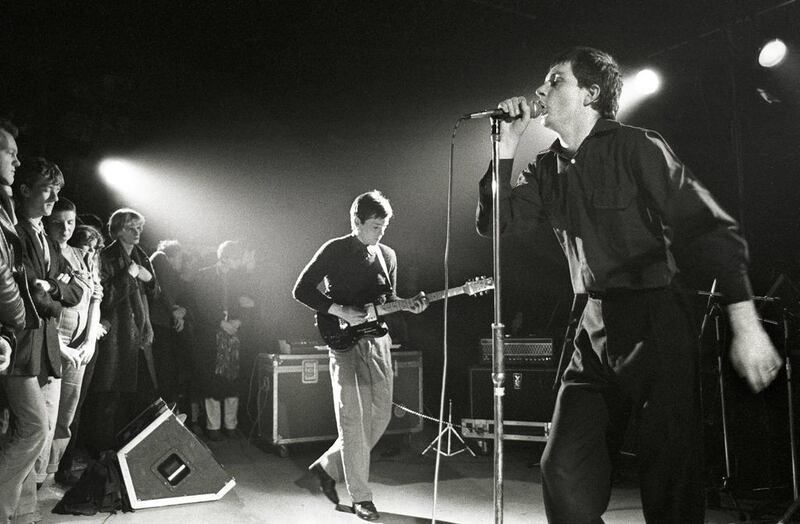There's an element of playfulness to the title of Greil Marcus's latest book. While The History of Rock 'n' Roll in Ten Songs [Amazon.com; Amazon.co.uk] suggests a linear narrative; a rather generic "list" book; some tunes from the canon crowbarred into a story many will already know, what we actually get is something much more ingenious and multilayered.
Marcus is a veteran music critic who was the first reviews editor at Rolling Stone. He's renowned for his acute prose and for his formidable head knowledge. Right at the start here, he does something audacious: he lists every single inductee to The Rock and Roll Hall of Fame, the American music awards institution in Cleveland, Ohio. The roll call stretches to six pages, testing our patience and making us wonder what Marcus is up to. Then it dawns on you: he's showing us how pedestrian and predictable conventional histories can be, how much incident and wonder they let fall through the cracks.
Railing against this state of affairs, the author’s own history of rock ’n’ roll is an alternative one. It, too, is selective of course, but Marcus’s selections are always thought-provoking, and never lazy. Slipping “the constraints of chronology”, the book alights on (mostly) lesser-known songs and versions, and shows how they can resonate through time, gaining meaning and import. It’s an intellectual pursuit, certainly, but our host’s writing can be beautiful, challenging, funny or pleasingly irked.
In the chapter titled All I Could Do Was Cry – it juggles takes on the said song by Etta James and Beyoncé – Marcus has a pop at New Yorker columnist George Packer, who described Bey's dazzling, February 2013 Super Bowl performance as "…a highly polished combination of corporate marketing and pole dancing", something that left him cold. "The scent of failure came off [Packer's] words," counters Marcus. "You could feel that he had demeaned himself, not her."
For all Marcus’s admiration for Beyoncé, it’s Etta James’s original version of the song he prefers, and for sound reasons. The opening couplet, “I heard church bells ringing / All I could do was cry”, finds a woman bearing aural witness to the man she loves marrying somebody else. James was only 21 when she cut the song in 1960, but its story became a self-fulfilling prophecy, something she would actually experience.
Marcus goes on to point out that, in 2007, when James learnt that the much younger, picture-perfect Beyoncé would play her in Cadillac Records, a film in which the recording of All I Could Do Was Cry is depicted, she wasn't pleased. "She's going to have a hill to climb, because Etta James ain't been no angel," remarked James. Again, we see that something of the true and thornier story of rock 'n' roll is being airbrushed out, a point underlined when Marcus reminds us that it was Beyoncé, not the still capable James, who was called upon to sing At Last, a song James made famous, at President Obama's first inaugural ball.
Another of the book's themes is that rock 'n' roll is at root an expression of freedom, an attempt to slip the constraints of something. But in a chapter exploring different versions of the Joy Division song Transmission, Marcus must concede that, for all singer Ian Curtis's cathartic performances – visually, they seemed to mirror the epileptic fits he famously suffered from – rock 'n' roll could only salve so much of the singer's pain.
Naturally, the author's account of a band crushed by their frontman's suicide is handled sensitively, but it also becomes the jumping-off point for wider rumination on the evolution and roots of punk. Perhaps only Marcus could make such a convincing leap from there to Rowan Joffe's 2010 film adaptation of Graham Greene's 1938 novel, Brighton Rock. Having done so, he asserts that, when small-town hoodlum Pinkie surreptitiously records bilious feelings about his girlfriend Rose on a "make a record of your own voice" machine, he is in fact making the first punk single.
There are also moments when the author makes inspired flights of fancy, imagining how the lives of musicians who died young might have panned out had they lived to a ripe old age. Robert Johnson, the fabled Delta bluesman who died at 27 near Greenwood, Mississippi, in 1938, is given the Lazarus treatment in a fertile, stand-alone chapter titled Instrumental Break.
Marcus has an elderly, well-heeled Johnson living in New York and writing the sleeve notes for a reissue of his own 1930s recordings. He's acquired an able lawyer and is finally getting the royalties due to him. Now 101 years old, Johnson also notes that Bob Dylan has namechecked him in Chronicles and that Mick Jagger "looks older than I do". In Marcus's fantasy world, it is only Johnson's mythology that suffers for him not dying young, for him being tangible: "Without the legend of a young man selling his soul to the devil, [his] old music didn't become a cult, merely a musical talisman."
Elsewhere, Buddy Holly gets a chapter exploring his song Crying, Hoping, Waiting, and why it meant so much to The Beatles just prior to their break-up. Marcus posits that, had Holly not died at 22 in a 1959 plane crash at Clear Lake, Iowa, he would have continued down his well-established road of pop innovation, perhaps also working as a Brill Building songwriter alongside the likes of Carole King and Gerry Goffin.
Entertaining and, at times, funny as Marcus’s book is – The Flamin’ Groovies have “a name so stupid it can’t transcend its own irony, a name so stupid it’s embarrassing to say out loud”, he notes at one point – his prose just occasionally gets purple.
"When the guitarist steps onto the magic carpet of his first solo," he writes, describing the aforementioned group's Shake Some Action, "it is a picture of everything the singer is certain is slipping away from him, but it is not slipping away, it is present, you can hold it in your hand, see it glow."
I went back to listen to The Flamin' Groovies' Shake Some Action, and fine though it is, I couldn't see that picture, couldn't hold it in my hand and couldn't see it glow. That's probably just me, and it would be unfair to chide Marcus for daring to walk the imaginative plank, as he so often – fruitfully – does. Here he is on better, much more typical form, describing Barrett Strong's lead vocal on another of his book's selections, the 1959 single Money (That's What I Want): "Go back and listen to him sing the first line and you can't believe it's the same person. It isn't: the song insisted that he become someone else, and for just short of two minutes of the two minutes 35 seconds of the record, he did."
Marcus also homes in on To Know Him Is to Love Him, teasing out the fascinating threads that bind Phil Spector's 1958 original (with his group The Teddy Bears) to a 2006, live-on-the-radio cover of the song by the late Amy Winehouse.
Most resonant and haunting, though, is the chapter in which he explores sound-artist Christian Marclay's extraordinary video piece Guitar Drag, a work that manages to reference both Jimi Hendrix's deliberate destruction of his Fender Stratocasters and the brutal white supremacist lynching of James Byrd Jr that shamed Jasper, Texas, in 1998.
Early on in the book, the author makes the point that, “rock ’n’ roll may be more than anything else a continuum of associations”, and that, it seems, is one of the key points to take away here. Marcus’s gift is to immediately see or painstakingly sniff out the associations that have most meaning and/or emotional resonance, then tease them out into fascinating, expertly constructed essays. Along the way, he entertains as much as he informs.
James McNair writes for Mojo magazine and The Independent.
[ thereview@thenational.ae ]










